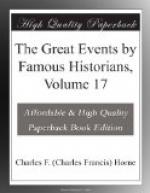He had not long to wait. Almost immediately after the issue of the proclamation another gold-field was discovered on the Turon River, also a feeder of the Macquarie, only a few miles from Lewes Pond; and shortly afterward a third was opened up on the Abercrombie, a tributary of the Murrumbidgee, which takes its rise in the Cordillera, south of Bathurst. By the beginning of June, gold began to pour into Bathurst; but Mr. Hardy, the chief commissioner, was able to report an almost idyllic peace and plenty at the diggings.
In the middle of July an event occurred which at once produced a violent attack of gold fever. This was the discovery of an enormous mass of virgin gold, weighing upward of one hundred pounds, by Doctor Kerr, a squatter on the Meroo Creek. Doctor Kerr had been guided to the spot by an aboriginal who had been in his service several years; and, in his excitement, he broke the matrix in which the nugget was imbedded, and thus spoiled what would have been the most magnificent specimen of gold quartz hitherto discovered. Even as it was, the display in Bathurst of a single find of gold worth four thousand pounds was enough to excite the feelings of the inhabitants to a pitch inconsistent with steady industry.
But Doctor Kerr’s find raised a point of some interest to the Government. In framing the licensing regulations, the advisers of the Crown had thought only of the possibilities of alluvial mining. Had they even directed their thoughts toward rock gold, they would probably have considered it highly improbable that any explorer should be able to extract the metal without an amount of preparation which he would hardly undertake upon the security of a bare license. But, as it happened, Doctor Kerr had not even a license when he discovered the gold, though he took one out as soon as possible afterward. To strengthen its position, the Government seized the gold in the hands of a firm of shippers who were about to send it to England; but, on the firm’s representation, it was released, security being given for the payment of a royalty of 10 per cent, if the Crown should see fit to demand it.
Early in August, 1851, the Governor announced that, for the future, licenses would be held to cover only alluvial gold, and that for rock gold found on Crown land the Government would demand a royalty of 10 per cent., half that amount if the working was on private land. A fortnight later the Government undertook the escort of gold from the diggings to Sydney, thereby adding considerably to the Crown revenue and at the same time obtaining additional power over the gold districts. By the end of August, gold to the value of seventy thousand pounds had been exported from the colony. But these figures were soon eclipsed by those which followed.




